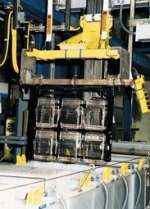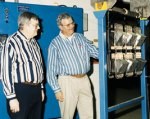Electropolishing for the Future
Leonhardt Plating needed to expand its family business, if it was to stay a family business...
Several years ago, Leonhardt Plating, Cincinnati, OH, simply maintained its status quo. Sales weren't going up, but they really weren't going down either. However, the owners, Dan and Kerry Leonhardt, weren't happy with that. They were looking to the future, theirs and their children's. If Leonhardt Plating was to remain a family business, something needed to change.
They met with the Cincinnati Chamber of Commerce to plot some strategic planning. "It was the kick we needed to straighten us out," noted Kerry. Because of the planning meetings, Leonhardt Plating decided it needed to offer more finishing services in addition to nickel, chromium and electroless nickel plating and polishing and buffing it already provided.
"We considered powder coating," said Dan. "However, we are a job shop that handles smaller runs, 50 to 5,000 parts so we did not think it would be feasible considering color changes. If we offered powder coating we would also need to install cleanrooms and more than we were ready to invest in and maintain. So, we did some research and finally chose electropolishing."
Prior to installation, the Leonhardts toured several facilities in Ohio and Kentucky to examine other electropolishing installations. "Belonging to the National Association of Metal Finishers and the American Electroplaters and Surface Finishers Society helped us get in to these other shops. We knew each other, and the other shops were willing to cooperate with us," Dan commented.
And, it just so happened that Leonhardt was in the right place at the right time. A large local plating shop that offered electropolishing shut its doors, and Leonhardt was able to hire some of its experienced people and procure some of its electropolishing customers. "This helped us get our feet firmly planted on the ground the first year," said Kerry.
And so, Leonhardt Plating began its adventures in electropolishing. "It is the opposite of plating," explained Kerry. "Instead of plating metals onto a part, it removes the metal, leaving a smooth surface."
The electrolytic (electropolishing) bath smoothes, polishes, deburrs and cleans stainless steel and other metals by selectively removing high points on the metal surface. The part is made anodic and a metal (usually lead, copper or stainless steel) is made cathodic. Direct current (150 to 300 asf) flows from the anode to the cathode, removing metal ions in the process. The amount removed depends first on the customers' specifications, but temperature, current density and the alloy in the electropolishing bath also affect the amount of metal removed.
When electropolishing stainless steel, elemental iron is removed, and a layer of chromium-rich oxide forms on the surface. This oxide film is thickest over depressions and thinnest over projections. At the projections the electrical resistance is least and current density greatest; therefore, the effects of electropolishing are also the greatest. The oxide layer also provides for minimal moisture absorption, surface cleanliness and high corrosion resistance.
The smoothness and high reflectivity also depend on the condition of the substrate. "Most of our parts come in clean," stated Kerry. "Our most prevalent cleaning problem is probably weld scale." Parts with weld scale are treated in an acid-based cleaner prior to electropolish. Parts that arrive oily are cleaned in baskets in an off-line citrus cleaner. The parts that arrive clean go directly into the electropolishing tank.
Other conditions that affect the electropolishing process include nonmetallic contamination, over-pickling, heat scale, large grain size, directional roll marks, insufficient cold reduction or excessive cold working. Because metal is removed during electro-polishing, flaws are revealed.
Applications for electropolishing at Leonhardt include piping/tubing, valves, fittings, sheet metal, stampings, castings, wire goods, fasteners, filters, compressors, cooling coils, turbine blades, wheels and impellers and electronic parts.
Electropolishing provides an excellent inner and outer diameter finish to tubing/piping. Therefore, it is used for food and beverage processing equipment and medical equipment. The smooth, easy cleaning and cosmetically pleasing surfaces also have non-contamination and sanitary qualities.
Leonhardt Plating electropolishes mostly stainless steel, but has the capability to electropolish aluminum, brass and carbon steel. Other metals that can be electropolished include copper, beryllium copper, bronze, nickel, nickel-silver, wrought aluminum alloys, titanium and gold, among others.
"No matter what type of metal we electropolish, one of our biggest concerns is keeping the bath at a steady temperature," noted Kerry. To maintain the temperature, Leonhardt changes rectifier settings and uses a closed-loop cooling system. In the cooling system, water from one of the rinse tanks is pumped through a Teflon tube that runs through the bath and back to the evaporator.
In spite of its efforts to maintain temperature, Leonhardt has found that some jobs run better at 140F and others at 160F. "There is a learning curve," stated Dan. "Some electropolishing cycles run three minutes and others may take five. Longer cycles build up more heat. But, the processing depends on what the customer wants."
The entire system is also closed-loop as well as zero discharge. Ion exchange systems treat rinse waters. When the bath is saturated (approximately every six months), it is hauled away for treatment. Saturation depends on metal concentrations in the bath.
Leonhardt has also done non-traditional electropolishing of vessels for suppliers to the milk, beer and chemical industries. This involved pumping the electro-polishing solution in to the vessel rather than submerging it in a tank. Anodes are fixtured within the vessel and electrodes are attached. Then you fill the tank.
Since JPS Technologies manufactured and installed the electropolishing system, sales and profits have risen dramatically. This has allowed both Dan and Kerry to seriously contemplate retirement. "The boys (Scott, Joe, Kevin and Steve Leonhardt) are ready for me to retire now," laughed Dan. "Turning over the business to other family members is not an easy thing to do. I started working on it about three years ago, and it will probably be another four before I'm ready to let go."
To learn more visit JPS Technologies, Inc..
Read Next
Education Bringing Cleaning to Machining
Debuting new speakers and cleaning technology content during this half-day workshop co-located with IMTS 2024.
Read MoreDelivering Increased Benefits to Greenhouse Films
Baystar's Borstar technology is helping customers deliver better, more reliable production methods to greenhouse agriculture.
Read MoreA ‘Clean’ Agenda Offers Unique Presentations in Chicago
The 2024 Parts Cleaning Conference, co-located with the International Manufacturing Technology Show, includes presentations by several speakers who are new to the conference and topics that have not been covered in past editions of this event.
Read More



















.jpg;maxWidth=300;quality=90)





